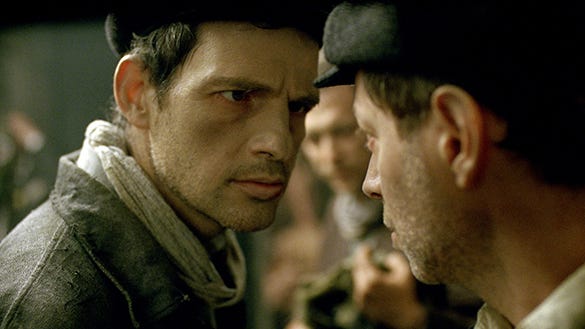Son of Saul

A deserved winner of the Academy Award for Best Foreign Language Film “Son of Saul” takes a very innovative approach in telling a familiar and heartbreaking tale.
This Holocaust drama from Hungary looks at the Sonderkommando — Jews kept alive and granted a sort of immunity to shepherd their fellows into the gas chambers, and then load the bodies into the crematorium or earthen pit. Their reprieve is temporary, though, as the Nazi regime makes sure to cycle them out every few months to eliminate evidence of their crimes against nature.
They are ferrymen on the river of death, destined to become passengers themselves.
Saul (Géza Röhrig) is quiet and grim, known for blending into the background and keeping his head down. But one day he observes a boy who somehow survived the deadly gas but is then coldly suffocated by a German doctor. Saul claims him as his own son, and becomes determined to see the lad given a proper Jewish burial, with a reading of Kaddish by a rabbi.
Is this really his child? It seems more like delusion. But Saul’s obsession is less about preserving the boy’s dignity than reclaiming some measure of his own humanity. He sneaks through the camp, putting his own life at risk and those of other Jews, trying to find a rabbi and get the body out.
Meanwhile, the Sonderkommando leader is organizing a rebellion and escape, and Saul is lured into the plot. He agrees, but only since it grants him some freedom of movement to pursue his own goal.
Director László Nemes, in his directorial debut, uses a roving camera with a shallow depth of focus to keep our perspective in line with Saul’s. Here’s a man who has spent the last months of his life never looking past the 10 feet in front of him, in order to keep the greater terror obscured.
We see things in the background of the frame, somehow made more disturbing by remaining indistinct. Nemes lets our imaginations bring our own clarity to the fuzziness.
Here is a story of horror, from which we cannot — and should not — avert our gaze.
Bonus features are limited in scope but of great depth.
They’re centered around a feature-length commentary track in which Nemes, Röhrig and cinematographer Mátyás Erdély all participate. I always feel the best commentaries are those that combine multiple levels of the creative process. The triad of filmmaker, performer and visualist are what make this movie great.
There is also a Q&A from an appearance at the Museum of Tolerance, and a deleted scene.
Film: 4.5 Yaps Extras: 4.5 Yaps



